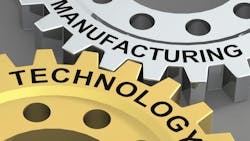Crystal Ball 2025: Uncertainty and opportunity in manufacturing technology
A note from Scott Achelpohl, managing editor, Smart Industry:
Welcome to the Crystal Ball Report for 2025, which will appear in this web space the rest of December and into January as a series of contributed pieces from esteemed experts in manufacturing technology.
We've invited these thought leaders to look into their "crystal balls" and tell us what's ahead (with an emphasis on data, AI, and cybersecurity). So please enjoy the series and, from all of us at SI, have a happy and safe holiday season.
What's in the Crystal Ball Report for 2025:
- Crystal Ball preview: Top cybersecurity risks in 2025 and beyond, by Carlos Buenaño, Armis
- The opportunity for AI-powered digital transformation, by Aaron Merkin, Fluke Reliability
- Cybersecurity top of mind for utilities, by Sally Jacquemin, Aspen Technology
- New year will demand streamlined data management, by Dwaine Plauche, Aspen Technology
- Workforce … industrial metaverse … reshoring … sustainability … China … all 2025 focus areas, by Ethan Karp, MAGNET
- Security in 2025 won't be just for the IT team, by Joe Anderson, TechSolve
After a boom-and-bust roller-coaster of pandemic, war, supply chain chaos, and crippling worker shortages, many are hoping 2025 will be the year manufacturing finally gets a reprieve. Unfortunately, it won’t.
See also: Intel risks gutting itself by spinning off its chip foundry
With a new, all-Republican U.S. government, the looming threat/promise of tariffs, and an uncertain economy, there’s more instability ahead. However, after the trials of the past few years, industries have become faster, smarter, and more resilient than ever. And opportunities will continue to flow to those who move quickly and invest smartly in both people and machines.
Here are six key places to watch in the year ahead:
Tech skills are the new trade skills
Robots and automation aren’t taking manufacturing jobs, they’re making human factory jobs safer and higher-tech. Advanced technology is critical to competitiveness and to help fill the gaps left by the worker shortage. The incredible speed of transformation means tech skills are the new trade skills—every manufacturing worker needs them now.
See also: Six ways to incorporate AI into your manufacturing operations
That means every company needs a clear plan to invest in training and upskilling their workforce. The worker shortage isn’t going anywhere. U.S. manufacturing will need to fill 3.8 million jobs over the next decade. Focus on retention—turn the workforce you have into the workforce you need.
More of the Crystal Ball series:
- Insights on 2025 from talks with manufacturers, by Josh Cranfill, Quickbase
- AI, automation, and insider threat detection, by Chris Scheels, Gurucul
- Business leaders should look inward to identify what they can control, by Michael van Keulen, Coupa
- Cybersecurity trends that will reshape private content security, by Patrick Spencer, Kiteworks
- Configurability, modularity, and AI: The 2025 challenges, by Damantha Boteju, Henrik Hulgaard, and Daniel Joseph Barry, Configit
- The rise of resilient manufacturing, by Aron Brand, CTERA
- 2025 prediction thread, Part 1, by various authors
- 2025 prediction thread, Part 2, by various authors
- Your opinion counts: Results from SI's reader poll on 2025, by Scott Achelpohl, Smart Industry
Expect to see an increase in public-private training partnerships, apprenticeships, and investment in reskilling programs that focus on advanced technical skills and cross-training.
See also: Partners in IoT that made perfect sense
Look at programs that blend technical training with soft skills, giving employees not only the ability to operate complex machinery but the confidence to troubleshoot, problem-solve, and collaborate. This is what will define the tech-first manufacturing workforce of the future.
The industrial metaverse is getting real
There’s been much talk about Industry 4.0 and smart manufacturing. With good reason, since smart manufacturing in the U.S. is predicted to be a $146 billion industry by 2030. It represents the single greatest opportunity to increase competitiveness, optimize efficiency, reduce costs, and drive profitability.
The tech focus of 2025 will be the industrial metaverse which means using advanced technologies like digital twins, IoT, AI, and virtual reality to create immersive, real-time simulations of industrial processes. This enables manufacturers to design, optimize, and manage operations virtually. More factories will converge their digital and physical operations like this, enhancing efficiency, collaboration, and innovation.
See also: New report reveals ‘grind’ of digital transformation, slow road to success
Data is rapidly becoming the new assembly line, and it powers the industrial metaverse, creating smart factories with sentience and foresight. Digital twins monitor equipment in real time and predict machine failures before they happen.
Prototypes are developed and tested entirely virtually with simulations, making innovation faster and cheaper. AI is an emerging hero across systems. And it won’t be something reserved for tech giants; it will be built-in to many of the machines that small and large manufacturers use daily.
This is the year to start stacking the building blocks of your industrial metaverse so you can eventually seamlessly connect systems and technologies, make your data intelligent, and innovate at the speed of software.
Electric vehicles will be a manufacturing boon
By the end of 2025 there will be 85 million electric vehicles on the road. But this is not a story about cars. The impact of EVs on manufacturing will go far beyond automakers. Companies across the industry are racing to build EV components, develop battery technology, and establish the infrastructure needed to support electric fleets.
Podcast: What awaits manufacturing in 2025
The future of manufacturing in America is intrinsically linked to the $95 billion EV market. The EV pendulum has swung back and forth, but it’s still a good long-term bet. Of course, there will be much disruption ahead as billions of dollars in traditional automotive manufacturing disappear. But there’s billions more in EV opportunities for manufacturers who think ahead and find a way into this ecosystem now.
In 2025, we’ll see more parts suppliers, material manufacturers, and electronics producers all pivoting to meet the demands of the EV revolution, which will have a profound ripple effect across the manufacturing supply chain.
Webinar rewind: 'Next Year’s AI' and more 2025 industrial technology insights
Another possible negative swing of the pendulum will come if the Trump administration moves ahead with its plan to abolish the $7,500 EV tax credit. This could stall the EV transition in the short term and devastate some EV makers, but Tesla apparently supports the move, believing its sales would only drop slightly.
Reshoring will redefine domestic production
Pandemic, war, and geopolitical upheaval has exposed the glaring weaknesses in our supply chains and the short sightedness of our over-reliance on China.
In a bid for stateside resilience, massive investments are being made to bring home critical manufacturing to the U.S. and shore up supply chain weaknesses. One of the most significant being the $280 billion CHIPS Act, a pivotal force reshaping the U.S. manufacturing landscape.
See also: Why intelligent information sharing is critical to resilient manufacturing
Support for U.S. manufacturing is stronger than it’s been in a generation and reshoring and nearshoring (primarily to Mexico) are on the rise. With planned tariffs against China (and possibly even Mexico and Canada), it’s expected that under the new Trump administration reshoring will gain even more momentum.
And this won't just mean moving factories back—it means creating new high-tech, automated facilities that leverage advanced robotics and AI to compete globally, like the new $20 billion Intel chips plant in Ohio. Expect advanced manufacturing hubs in states like Ohio, Texas, and Arizona to expand rapidly, becoming leaders in semiconductor production and other critical industries—redefining the future of American manufacturing.
Sustainability is the biggest driver of manufacturing innovation
Sustainability is no longer a cost center, it's a growth opportunity. When MAGNET recently surveyed manufacturers in Northeast Ohio, we found that sustainability was the single greatest driver of innovation, changing both what manufacturers make and how they make it.
Emerging opportunities in the EV and chips supply chains are key drivers of manufacturing innovation on the product side. On the operations side, sustainability is an important way to boost competitiveness. Consumers want it, governments mandate it, and manufacturers can’t afford to ignore it. Sustainability is here to stay.
Survey: AI speeding past ‘hype’ and toward ‘mature’ adoption, though IT and OT differ in use
Manufacturers are already adapting but expect these efforts to ramp up significantly. Some are rethinking their supply chains from the ground up, using recycled materials and sourcing from local suppliers to cut emissions. Others are implementing circular production models, reusing parts, minimizing waste wherever possible, and reducing energy consumption.
We won’t beat China in 2025, but the U.S. can still thrive as No. 2
In one year, China installed more manufacturing robots than the rest of the world combined. We are losing the high-tech arms race, and 2025 will not be the year we surpass China.
However, the U.S. can still thrive as a strong No. 2 by focusing on the areas where it excels: advanced manufacturing, innovation, and high-value production.
Strategic investments in technologies such as semiconductors, AI, and green energy, supported by policies such as the CHIPS Act, position the U.S. as a leader in these cutting-edge sectors.
See also: Why communication is as vital as technical skills for manufacturing cybersecurity teams
Additionally, by fostering resilient domestic supply chains, emphasizing workforce development, and prioritizing sustainability, the U.S. can secure its role as a global manufacturing powerhouse—one that may not match China's sheer volume but surpasses it in quality, reliability, and innovation.
And even at No. 2 globally, manufacturing still makes an incredible domestic contribution—adding almost $3 trillion to the U.S. economy. Instead of chasing China, 2025 should be the year we focus on building the best workforce possible to power the most advanced manufacturing industry possible.
U.S. manufacturing is redefining itself through technology, reshoring, sustainability, and a tech-first workforce. But this isn’t a passive shift. Leaders must aggressively invest in their teams, embrace new technologies, and meet opportunities head-on. And do it with plenty of the resilience that has gotten the industry this far.
About the Author

Ethan Karp
Ethan Karp is president and CEO of MAGNET, which is part of the Ohio Manufacturing Extension Partnership and the MEP National Network, which advances U.S. manufacturing by helping small and medium-size manufacturers grow, make operational improvements, and reduce risk.

